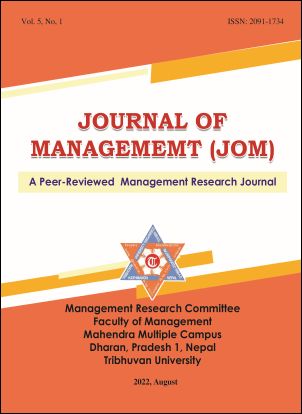Determinants of Nepal's Foreign Exchange Reserve: An Empirical Study
DOI:
https://doi.org/10.3126/jom.v5i1.47763Keywords:
foreign exchange reserve, exchange rate, ARDL, impulse response functionsAbstract
With the intent to fill the gaps in the empirical literature on foreign exchange reserve in Nepal, the paper aims to evaluate the empirical evidence of determinants of foreign exchange reserve in Nepal and to investigate the dynamic relationship among variables of interest using an autoregressive distributed lag (ARDL) error correction model and impulse response functions (IRFs) with 40 years of data from the period 1980-2020. The stylized facts of the employed model in the short run, reveal that the previous year's foreign exchange reserve itself, and all other predictors except gross fixed capital formation and official exchange rate (have negative) have a positive effect on foreign exchange reserve. The empirical evidence also insights that net flows of foreign direct investment, GDP per capita, inflation, and official exchange rate have positively influenced the foreign exchange reserve in long run. On the contrary, gross fixed capital formation has negative effects in long run. Moreover, anticipated crucial proxies––current account balance and trade are positively influenced but not significant. However, any impulse on the current account balance reports a significant response of foreign exchange. Thus, the central bank of Nepal and policymakers are needed to focus on the productivity of gross fixed capital formation or domestic investment to maintain the reserve adequacy and should give their attention to the current account balance (import and export) that can maintain the foreign exchange reserve and financial/economic stability and safety.
Downloads
Downloads
Published
How to Cite
Issue
Section
License
© Management, Research Department, Faculty of Management, Mahendra Multiple Campus, Dharan, Nepal

